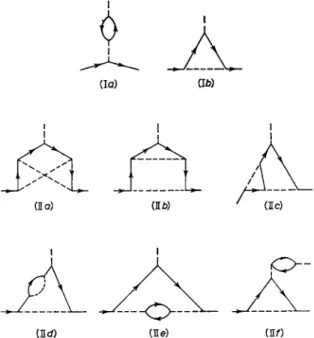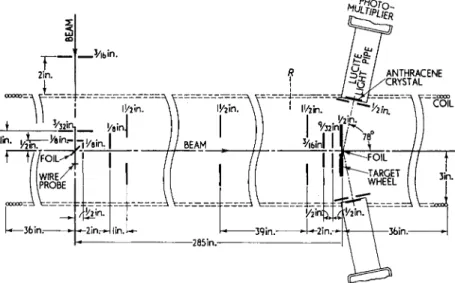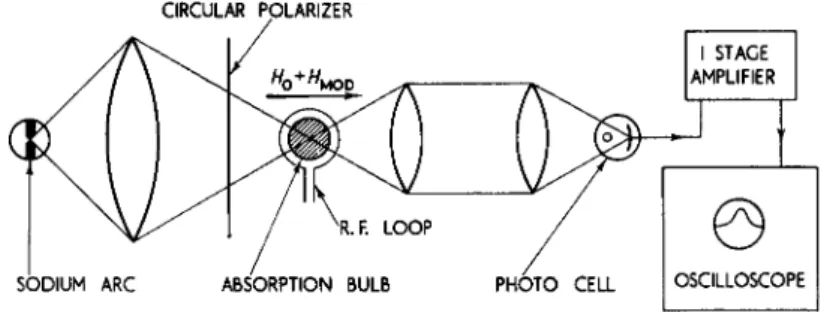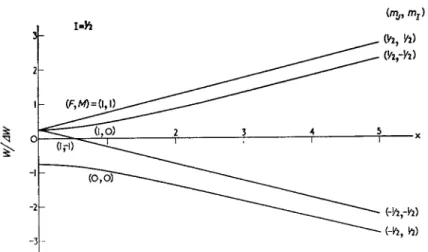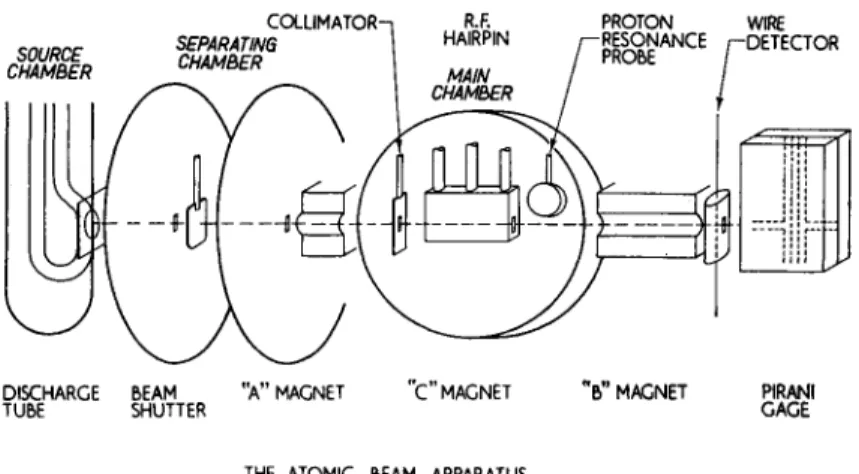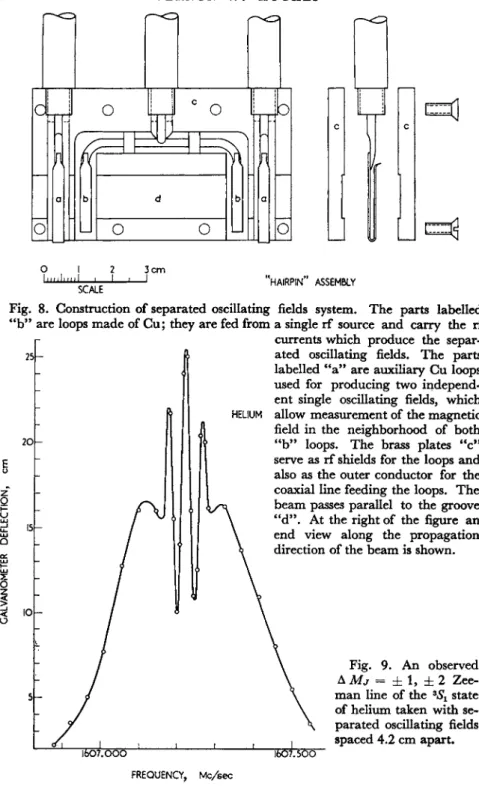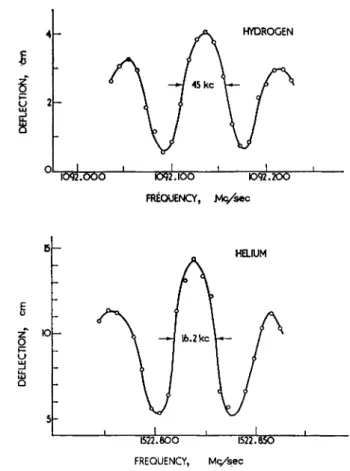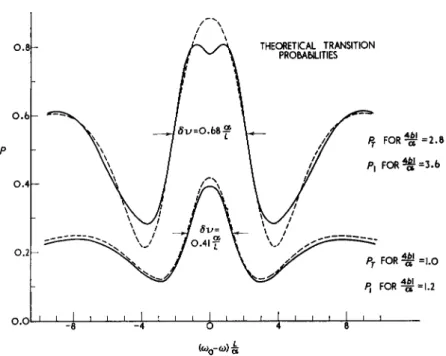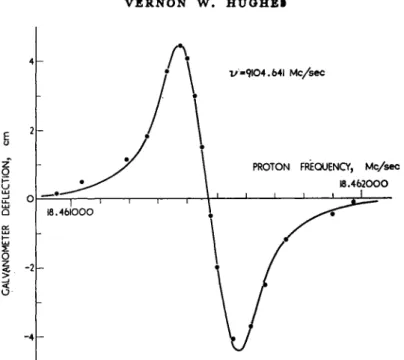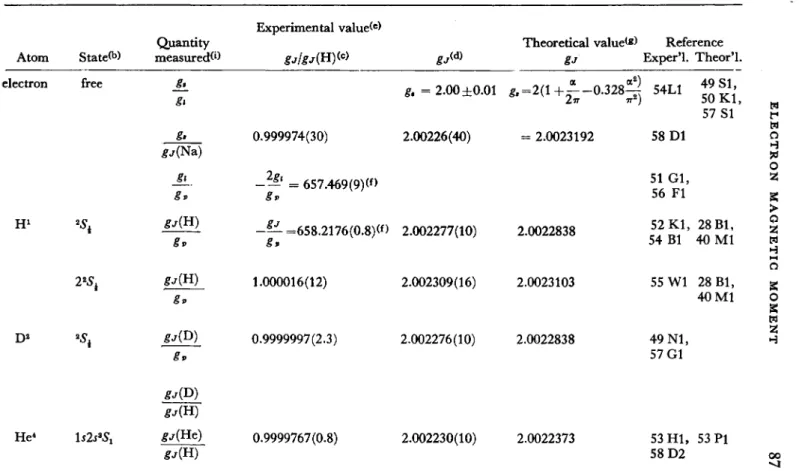4
Electron Magnetic Moment and Atomic Magnetism*
VERNON W. HUGHES Yale University, New Haven, Connecticut
I. I n t r o d u c t i o n
T h e original stimulus for recent precise measurements of atomic electronic magnetic moments or gj values was the interest in the spin magnetic moment of the electron. T h e discovery of the L a m b shift1 and the disagreement of the measured value of the hyperfine structure splitting in hydrogen2 with the value computed from the Fermi formula led to the suggestion that the spin magnetic moment of the electron is larger than 1 Bohr magneton.3 Comparisons of experi- mentally determined gj values in different atoms in states involving both orbital and spin electronic magnetic moments proved the exis- tence of an anomalous magnetic moment of the electron about 0 . 1 % larger than the Bohr magneton.4
T h e anomalous spin magnetic moment of the electron arises from virtual radiative processes involving photons and electron-positron pairs. O n the basis of modern q u a n t u m electrodynamics its value has been computed to order a2 (a = fine structure constant), and hence to an accuracy of about 1 p a r t in a million.5 T h e most accurate experi- mental determination is obtained from a comparison of the g j value of hydrogen in its ground state with the orbital g value, gi, of the free electron, and has an uncertainty of about 10 parts in a million.6
Atomic gj values of many multielectron atoms have been measured to an accuracy of about 1 p a r t in a million and the theory of atomic magnetism has been extended to order a2 to include the relativistic as well as the virtual radiative contributions to atomic magnetism.7 Par- ticularly for the case of helium a strong confirmation of the theory of
* The preparation of this article was aided in part by the Office of Naval Research, the Air Force Office of Scientific Research and Development, and the National Science Foundation.
65
the relativistic contributions has been achieved.8 Substantial discrep- ancies exist between the experimental and theoretical gj values for many other multielectron atoms. The most likely explanation of these discrepancies appears to be the inadequacy of the atomic wave- functions available for the computations, and hence experimentally determined gj values can be used as a test for atomic wavefunctions.
From another viewpoint, if adequate atomic Schroedinger wave- functions were available for multielectron atoms, the highly precise experimental gj values could be used to obtain the value of the spin magnetic moment of the electron to a higher precision than it is presently known from experiments on hydrogen and the free electron.
T H E O R Y OF A T O M I C M A G N E T I S M
Π. Electron spin magnetic moment
The Dirac theory of the electron predicts that the spin magnetic moment of the electron is 1 Bohr magneton
i ,M,= L·)
and hence that the spin g-value of the electron is 2.
Γ p __ spin magnetic moment (in units of μ 0) *|
L° s spin angular momentum (in units of Ä) J
Corrections to the Dirac theory value of gs = 2 arise due to virtual radiative processes. The order a and a2 corrections have been computed by the modern covariant, renormalized theory of quantum electro- dynamics5 and the Feynman diagrams which contribute are shown in Fig. 1. The theoretical value is:
*- 2 Κ-°· 328 3 (1)
= 2 [1 + 0.0011614-0.0000018] (la)
= 2 Π.0011596] (lb)
E L E C T R O N M A G N E T I C MOMENT 67
0
(Ισ)
(Πσ) (lb)
ίθ-
(JLd)
Fig. 1. Feynman diagrams for radiative corrections contributing to the anomal- ous spin magnetic moment of the electron. Solid lines indicate electrons and dashed lines indicate photons or the external magnetic field. Diagrams I give
order a radiative corrections; diagrams II give a2 corrections.
III. Atomic gj-values
The theory of atomic magnetism for a multielectron atom is based on a generalized Dirac-Breit equation with the addition of a term to represent the interaction of the anomalous spin magnetic moment of each electron with the external magnetic field.7 The equation reads:
g [ßk mc* + ak. (cpjt + eAk)] + V+ j ? B™ + Ω*o } ^ = ΕΨ (2)
k=l l>k=l
E is the stationary state energy, including the rest energy of the n elec- trons; Vis the sum of the electrostatic interactions:
n yp2 n
k=l l>k=l
(2a)
in which — e is the electron charge, Ze is the nuclear charge; p# is the momentum of the M i electron; A* is the vector potential of the external field at the kûi electron and for a field Ho constant in space and time,
Ak= l / 2 H0x r * ; (2b)
oat, ßk are the Dirac matrices; Bki is the Breit interaction A;th and /th electrons,
in which tki = r* —17;
ü f f
° = ^ 0 {L· ~ °' 328 ^)Σ σ * ,,Ηο (2d)
k=l
is the interaction of the anomalous part of the electron spin magnetic moments with the external field Ho, in which ok' is the 4 x 4 Pauli spin matrix; the wave function Ψ depends on n space coordinates tk and on n 4-component spinor variables.
The magnetic interaction term linear in Ho is computed with first- order perturbation theory by evaluating the diagonal matrix element of:
n
for the zeroth order wavefunction To obtained from Eq. (2) with the omission of the Hamiltonian terms (3) which depend on the magnetic field. Another equivalent procedure is to derive a Schroedinger-Pauli equation from Eq. (2) and then to evaluate by first-order perturbation theory the energy term which depends linearly on Ho. Higher-order terms in Ho correspond to diamagnetic corrections and are usually negligible. The result for the magnetic interaction energy can be expressed :
EHO = μogJHoMJ (4) in which Mj is the magnetic quantum number for the total electronic
angular momentum. The quantity gj can be expressed as a power series in a and the calculations are correct to the order of a2.
between the
(2c)
E L E C T R O N MAGNETIG MOMENT 69 The lowest order term for gj is the value obtained from the Schroedinger-Pauli theory. If the atom obeys Russell-Saunders coupling so that the total orbital angular momentum L and the total spin angular momentum S are separately constants of the motion, then
J(J+l) + L(L+l)-S(S+l) j(j+l) + S(S+l)-L(L+\)
gJ gL 2 / ( /+i ) +g8 2/(7+1) ( 5 )
in which gL= 1 and gs = 2. If the atom obeys the jy coupling scheme then the atomic magnetic moment results from the coupling of all the electronic magnetic moments characterized by their gj{ values. For the simple case of two electrons withjy coupling
JU+i)+Mh+i)-Mn+i). J(/+«)+*(*+ΐ)-Λ(/ι + ΐ)
* - f f t — m i T T ) + s < mm—~
(6) in which j i and 72 are the angular momentum quantum numbers for the two electrons.
For many of the atoms studied the Russell-Saunders coupling is a good approximation. However, slight deviations from this coupling scheme cause important perturbations in the theoretical gj values from the viewpoint of high precision measurements. If several states with the same configuration and the same total angular momentum quantum number/ are present, the spin-orbit interactions lead to an admixture of these states and hence to an alteration in the gj value obtained for a pure LS state. An example is the oxygen atom9 for which the ground state electronic configuration is ls22s22p*, and two of the LS states,
3P2 and 1Z>2, are admixed by spin-orbit interactions. The amplitude cjc of the admixture of the foreign LS state is given by first-order perturbation theory as the matrix element of the spin-orbit interaction between the two states divided by the energy difference between the two states, and the change in gj is cipkg in which Ag is the difference between gj for the initial and final states. For the case of oxygen the admixture cjc of W2 state with 3?2 state is 0.0065, and the change in gj for the 3P2 state is — 21 x 10-6.
More generally, a combination of electrostatic interactions between electrons which leads to configuration mixing and of spin-orbit inter- actions can cause the admixture of states of different L and S and hence can alter the gj value.24 The amplitude cjc of the admixture of the foreign LS state is given by second-order perturbation theory as:
EoiEoic
Voi is the matrix element of the electrostatic interaction between the zeroth-order state 0 and the state i having a different configuration but the same L and S values. £<* is the matrix element of the spin-orbit interaction between the state i and the state k which have the same configuration but different L, S values. Eoi and Z?ofc are the energy differences between states 0 and i and 0 and k, respectively.
The corresponding change in g value is
gJ
E
0m
kz
{)in which àg = gj^ — gj(0)· As an example, consider Na in its ground state with the zeroth-order configuration ls22s22p*3s9 2
£$. State i can be a configuration \s22s22p^3sZp, 2S± and state k can then be a 2P± or
4/% state. In Na the fractional change in gj is estimated to be about 1 part in a million ; the changes in gj are larger for the heavier alkalis, and for Cs it is about 7 parts in 105.
The effect of virtual radiative corrections is taken into account by using instead of gs = 2, the value given in Eq. (1) from the quantum electrodynamical calculation for the scattering of a free electron by an external magnetic field :
gs = 2 ί 1+ — - 0.328—1 = 2(1.0011596)
L 2Ή 7T2J
Relativistic contributions to the magnetic interaction energy of order αΡμοΗο arise from the Dirac-Breit equation (2). These contribu- tions can be expressed7 as the following expectation values:
un J\
AER = - - ^ - < U H o - V (L* + 0fc)p*2
k=l
àE
s= J^ < U | 2 a r V ^ x A ,
U> (9)
2mc2 U> (10)
AEB = < U > - —— — A*· 1 + — + Ar 1+ — - · — +
\ 1.4* l 2mcl>k=l 2 rjcil \ ni21 me \ rki2 / mc\
+ ——9(<*k'rkixAi + arnkxAk) \\U) (11)
E L E C T R O N MAGNETIG MOMENT 71 pto Ljb, σ*2 are the linear momentum, orbital angular momentum, and spin angular momentum operators for the kth electron; Vis the electro- static potential energy and A* is the vector potential at the position r*; of the kth electron; tw = r* —r^; C/is the normalized wavefunction which satisfies the Schroedinger-Pauli approximation equation:
— 2 (RMMM+MnRM + RicMMRt + RtMnRic)\U = WU
ί>£=1
Rk = -±JL*; Mkl = —— σ*·σι+ ' ; W = E-nmc*
mc 2mc*rjci\ r^r I
The contributions AJBR, AES, and ΔΕΒ are of the order αΡμοΗο and correspond to familiar contributions to fine structure of order cn2ry. Such a correspondence is to be expected in view of the occurrence of A* in the Dirac-Breit equation (2) only in the combination p# +
(ejc)Ajc. Since this combination occurs also in the classical Hamiltonian and equations of motion for electrons, the effect of a given external vector potential can be regarded as inducing the diamagnetic momen- tum (elc)Ajc in electron k to give it the total momentum p* + (*/<;)A*.
A general diamagnetic classical interpretation for magnetic interaction energies is thus possible. For example, the usual nonrelativistic contri- bution of order μοΗο has the well-known classical interpretation of diamagnetically-induced kinetic energy due to the product of mech- anical momentum p and the diamagnetically induced momentum eA/c (p may be taken as the original momentum for A = 0 ifeAjc <ζ ρ).
The contribution AER of Eq. (9) to αΡμ$Ηο is due to the "relativistic increase of mass" in which one factor of the fourth power momentum term is diamagnetically induced momentum. The contribution AEs of Eq. (10) has the classical spin-orbit energy explanation with eA/c replacing p. The contribution ΔΕΒ of Eq. (11) corresponds to the spin A-orbit / and to the orbit-orbit interaction energies with eA/c replacing p. From this point of view it is clear that spin-spin contribu- tions to fine structure have no analogous α2μ QHQ contributions. Accurate evaluation of A2?R, ΑΖζ$, and AEB requires a knowledge of the
Schroedinger wavefunction both as to its dependence on angular and radial variables.
The nucleus of the atom is treated as a point charge Ze of infinite mass in the Dirac-Breit equation. The effects of the nuclear mass, size, and moments can be treated by perturbation theory. The effect of the finite mass of the nucleus10 is obtained from the Schroedinger- Pauli equation by including terms for the total momentum of the nucleus and of each electron of the form p —(ς/ήΑ in which p is the linear kinetic momentum of the particle and A is the vector potential (A = (Hoxr/2)) for a uniform applied field Ho, r = position co- ordinate with respect to a fixed point, q — charge of particle. The coordinates of the center of mass of the atom can be separated out, and the following Hamiltonian magnetic interaction term is obtained due to the nuclear motion :
Pa = linear momentum of A;th electron; s^ = r^ — r# in which VN = radius vector for the nucleus; M = njass of nucleus. The first term in Eq. (13) is a simple reduced mass correction to the interaction of the orbital magnetic moment of the electrons with the external magnetic field. The second term involves a cross product between position and momentum coordinates of two different electrons and corresponds to the "specific isotope shift" or the Hughes-Eckart effect in atomic optical spectra. These effects of the nuclear mass are of order (τηΙΜ)μοΗο.
The finite size of the nucleus and the nuclear magnetic dipole and electric quadrupole moments alter the Schroedinger atomic wave- function obtained for a point charge nucleus, and admixture of states with different gj values can occur.11 Furthermore, the change of the nuclear electrostatic potential due to the finite nuclear size or the nuclear electric quadrupole moment will alter the relativistic contri- butions to the magnetic interaction. These effects are much smaller than the present experimental errors. For a mu-mesonic atom, how- ever, the radius of an atom with large Z is of the order of the nuclear radius, and the size of the nucleus will influence appreciably the value of the atomic magnetic moment. Precise measurements of the mag- netic moments'of mu-mesonic atoms, which are now possible, may thus yield useful information about nuclear structure.25
E L E C T R O N M A G N E T I C MOMENT 73 MEASUREMENTS OF ATOMIC MAGNETISM
IV. Free Electron
Considerations based on the uncertainty principle emphasize the difficulties of experiments to measure the spin magnetic moment of the free electron by classical type experiments, e.g. a magnetometer or a Stern-Gerlach experiment.12»13 Of the many attempts to measure the electron spin magnetic moment by quantum-mechanical type experi- ments, two experiments have been successful thus far, but their accuracy is considerably less than that obtained in measurements of atomic magnetic moments.
The spin magnetic moment of the free electron was first measured in an experiment which utilized Mott scattering for the production and analysis of the electron polarization and compared the electron spin precession frequency to the electron orbital cyclotron frequency.13 A schematic diagram of the apparatus is shown in Fig. 2. The incoming
2in.
r
1
Σ. S
t Viöin.
Ä
I " 3/32iy _ i/einj
lin· kfer'^^-lri'/ain·.
Π//FOIL·
WIRE/ ! PROBE
COIL
3in.
FOIL P^-TARGET
' \ WHEEL
Fig. 2. Schematic diagram of apparatus to determine the electron spin magnetic moment by use of Mott scattering for production and analysis of the electron
polarization.
electron beam of (420 ± 0.8)kev energy is obtained from a Cockroft- Walton generator. Mott scattering at 90° by a gold foil produces a partial polarization for the scattered beam transverse to the direction of the scattering. In the longitudinal magnetic field produced by a solenoid the electron spin precesses at the rate v8 = (β8μοΗο)Ι/ι. At
the position of the analyzing foil the orientation of the electron spin is determined from a study of the asymmetry in azimuthal angle of the electron scattering. Approximately 5 revolutions of the electron spin are obtained between the first and second scatterers in the field of 400 gauss. The magnetic field is measured by the cyclotron orbital frequency vi = (2£ζμο#ο/Λ) with use being made of the focusing property of the orbital motion at integral numbers of revolutions.
Relativistic corrections to v8 and vi cancel in the ratio vs\vi to a suffi- cient accuracy. The result of the experiment is gs = 2.00 ± 0.01, where the error is due pririiarily to inaccuracy in the determination of the spin orientation by the analyzer.
A spin resonance experiment on electrons in a plasma has recently been achieved using optical methods for the production and detection of the electron polarization.14 A schematic diagram of the experimental arrangement is shown in Fig. 3. Sodium atoms at a partial pressure
CIRCULAR POLARIZER
Fig. 3. Schematic diagram of experimental arrangement to determine the electron spin magnetic moment by use of polarized light to produce and detect
the electron polarization.
of about 10~7 mm Hg and argon at a pressure of 70 mm Hg are con- tained in a bulb and illuminated with circularly polarized sodium resonance radiation. A net polarization of the sodium atoms is pro- duced thereby. Periodically a discharge is excited to produce an electron density of some 3 x 108 electrons/cm3, and the electrons become polarized by exchange collisions with the polarized sodium atoms. In a magnetic field Ho an electron spin resonance transition can be induced by an rf magnetic field of frequency v8 = μο£*#ο/Α. The resulting change in net polarization then causes a change in polariza- tion of the sodium atoms through the mechanism of electron exchange collisions. Since the transmission of polarized sodium resonance radiation through the sodium atoms depends on the amount of polari- zation of the sodium atoms, the electron spin resonance can be detected
E L E C T R O N MAGNETIC MOMENT 75 by the resulting change in light transmission. The width of the electron spin resonance is largely determined by the electron spin polarization relaxation associated with electron-argon collisions. A Zeeman transi- tion AAfp = ± 1 in the F = 2 hyperfine structure level of the ground state of sodium can be induced in the magnetic field Ho also, and de- tected by the change in light transmission. The result of the experiment is the ratio of the spin g value of the electron g8 to the value gj(Na,2Si),
gs/gjiNa^Si) = 0.999974 ±0.00003
in which the error is due to electron spin relaxation processes and inhomogeneity of the magnetic field.
V. Hydrogen
The most precise value for the electron spin magnetic moment is obtained from a comparison of a Zeeman transition frequency in the ground state of H and the cyclotron orbital frequency of a free electron in the same magnetic field. This comparison of gj(H,2iS$) to gi has been obtained by two experiments. One is a measurement of gj(H.,2Si)lgp, in which gp, the g-value for a proton, is obtained from a proton resonance absorption experiment; the second is a measurement ofgilgp-
The hyperfine energy levels of the ground state of hydrogen in a magnetic field are shown in Fig. 4, and the energy levels are given by the Breit-Rabi formula :
AW
WP=J±IM = wgpH0M± — [1 + 2Mx+x*]* (14) where F is the quantum number for total angular momentum and M
is the associated magnetic quantum number; AW is the energy difference at zero magnetic field between the F = 1 and F = 0 hyper- fine levels; x = μο(&/ -gp)HofAW.
One measurement of gj(H.2Sy)lgp was done by the atomic beam magnetic resonance method.11 The transition (F, M) = (1,0)<->(1, — 1) was observed in a magnetic field near 1430 gauss at a frequency of about 3655 Mc/sec. With extensive shimming of the magnetic C-field the natural line width of 60 kc/sec corresponding to a 4 cm rf transi- tion region was obtained. A proton resonance absorption measurement was made in the same magnetic field. Since the hfs energy difference is known from atomic beam and microwave absorption experiments to an accuracy of about 0.1 ppm,15 the above experiment determines gjÇR?S±)Jgp. Due to diamagnetic shielding the magnetic field at the
(Vi, Yi)
Fig. 4. Energy levels of the ground state of hydrogen in a magnetic field.
protons differs slightly from the applied magnetic field and hence in the measured ratio gj(H-,2Si)lgp, gv should be interpreted as the g- value of protons in the sample used, which was a spherical sample of mineral oil. An accuracy of ± 1 ppm was obtained for gj(H.2S^)]gp.
A measurement of g jCH^S^/gp has also been made tby a microwave magnetic resonance absorption method using hydrogen gas.16 The experimental arrangement is shown in Fig. 5. Hydrogen atoms formed
PYREX-TO- QUARTZ GRADED SEAL
WAVEGUIDE TO GENERATOR
DISCHARGE TUBE
PROTON REGULATOR PROBE
,WAVEGUIDE TO BOLOMETER
O-RING DEMOUNTABLE VACUUM JOINT
-TO PUMPS
Fig. 5. Cutaway view of apparatus used for microwave magnetic resonance absorption experiments.
ELECTRON MAGNETIG MOMENT 77 in a discharge tube diffuse through a high Q microwave cavity placed between the pole faces of an electromagnet. Fixed frequency micro- wave power is fed into the cavity whose TE on mode is such as to have a component of Ηή perpendicular to the static magnetic field Ho of the electromagnet. If the static magnetic field is at the resonant value for a transition ΔΜ = ± 1 in hydrogen, microwave power transmitted to the bolometer will be reduced. At a frequency of about 9000 Mc/sec, the resonant magnetic fields for the two transitions with Δ/raj = ±1,
Ami = 0 were observed with a line width of about 200 kc/sec, which was due to magnetic field inhomogeneity and collision broadening. The proton resonance absorption frequency for a mineral oil sample was measured in the same static magnetic field so the ratio gj(R,2Si)lgp is determined. A statistical accuracy of ± 0.3 ppm was obtained.
The orbital cyclotron frequency of the free electron has been com- pared with the proton resonance absorption frequency in two inde- pendent experiments. In the first17 the electrons were obtained from a hot filament and the electron cyclotron resonance was observed by its effect on the electron trajectories. In the second18 the electrons were obtained by the photoelectric effect and the resonance was observed by a microwave absorption method. The sources of error in these measurements arise from inhomogeneity and nonconstancy of the magnetic field, diamagnetic effects, space charge effects, and the relativistic dependence of mass on velocity. The accuracy for each of these measurements is about ±10 ppm.
Combination of the average experimental values of gj(H,2Si)lgp and gi/gp yields the result:
gj(H*Si)
6 v " = 2[1.001139± 0.000010]
Use of the theoretical relativistic contributions AER and AEs of gi Eqs. (9) and (10) gives the relation:
&/(Η,^) = gs(l - a2/3) = g8(l -17.7 x 10-β) Hence the experimentally determined value of gs/gi is
g8jgl = 2[1.001156 ± 0.000010]
This experimental value is in agreement with the theoretical value gs/gi = 2[1.0011596], but it is not sufficiently accurate to test the fourth-order a2 radiative correction to the spin magnetic moment of the electron.
To ascertain experimentally that the gj value of hydrogen does not depend significantly on nuclear properties, the electron g value in the
ground state of deuterium gj(Dy2S^) has been measured. An early4 measurement by the atomic beam magnetic resonance method com- pared directly gj(D,2Si) with gj(H2S{) and found them to be equal to within the experimental error of ± 10 ppm.19 A recent measure- ment by the microwave magnetic resonance absorption method of gj(D*Si)lgp again yielded £j(D,aS't)/£j(H,Wl) = 1 to within the experimental accuracy of 1 ppm.20
VI. Other Atoms
Accurate measurements have been made of gj values of many atoms by the methods of radiofrequency and microwave spectroscopy. Al- though some of the earlier measurements on multielectron atoms were used for the determination of gsjgi for the electron, at present gj values for multielectron atoms are used primarily to test the theory of relati- vistic contributions to atomic magnetism or to provide a criterion for the excellence of an atomic wavefunction.
The gj value of the two electron system in the ls2s>*Si metastable state of helium has been studied particularly carefully both experi- mentally and theoretically. In an atomic beam magnetic resonance experiment the transitions ΔΜ = ± 1 , ±2 in helium and the transi- tion (F,M) = (1,0)*->(1, -1) in hydrogen were observed in the same magnetic field, and thus the ratio gj(He9zSi)lgj(H92St) was deter- mined. The first such experiment21 used a transition region with a single oscillating field and determined the ratio to an accuracy of
±16 ppm. The method of separated oscillating fields was used in a more recent experiment8 and allowed the achievement of narrow natural line widths despite the presence of magnetic field inhomo- geneities in the C-region. A schematic diagram of the apparatus used for the latter experiment is given in Fig. 6. A block diagram of the radiofrequency system is shown in Fig. 7. The "hairpin" arrangement for the separated oscillating fields is shown in Fig. 8. Line shapes for hydrogen and helium transitions obtained by the method of separated oscillating fields are shown in Figs. 9 and 10. For hydrogen, only transitions between the two levels (F,M) = (1,0) and (1,-1) are involved. For helium all three Zeeman levels M = 0, ±1 are in- volved. Theoretical line shapes for the three-level case near the central resonance are shown in Fig. 11. The experimental value obtained is
^ ^ = l - ( 2 3 . 3 + 0.8)xl0-«
E L E C T R O N MAGNETIG MOMENT 79
SOURCE CHAMBER
COLUMATOR- SEPARATING CHAMBER
PROTON WIRE RESONANCE /-DETECTOR PROBE
| il 1 i
jL
y S
DISCHARGE BEAM
TUBE SHUTTER "A" MAGNET C MAGNET B" MAGNET PIRANI GAGE
THE ATOMIC BEAM APPARATUS
Fig. 6. Schematic diagram of atomic beam magnetic resonance apparatus used for measurement of gj(He,8.Si)/gj(H,aiSf).
x
WM.V.RECEIVER
FREQUENCY ι ι UAD|S/|ONIC I I XTAL ι ι
f^AecHcENERATORHMIXERM
, COAXIAL WAVEMETER
LOW PASS FILTER
bSCILLATOR HELIUM INVARIABLE M STUB ATTEN. iTUNERp]
HYDROGENMVARIAbLE DSCILLATORn ATTEN.
SWITCH
LTSfÖDTJ
COAKIALUVARIABLE , I Γ « « Ι ™ I—I piCKOFF
vTVt
[ANI_
WIDE BAND AMPLIFIER
pi+
RECEIVER HKJFREQUENCY COUNTER
BAND PASS
AMPLIRER FREQUENCY METER PHONO.
HMfHra
TUNER
PROTON .RESONANCE OSCILLATOR
R.F.
I AMPLIFIER TO FREQUENCY COUNTER
I « N POWER (M) MONITOR
BLOCK DIAGRAM OF THE RADIO FREQUENCY SYSTEM
Fig. 7. Block diagram of the radiofrequency system used for measurement of
i; II i; ;i
cL_J o LJ rïïf Un HI \r(\ — Hr^h^
a b d
d>| | [ 11 i—11 o
c
o LJo
ife^llti
^ I n l l H I
b III W
o |U||N|o
l l l l l l l 3 cm J
SCALE HAIRPIN ASSEMBLY
Fig.
"b"
20
z
Q
I -
U ώ 15 LU ' Û
o
<
o 10
HELIUM
8. Construction of separated oscillating fields system. T h e parts labelled are loops made of C u ; they are fed from a single rf source and carry the rf currents which produce the separ- ft ated oscillating fields. T h e parts
labelled " a " are auxiliary Cu loops used for producing two independ- ent single oscillating fields, which allow measurement of the magnetic field in the neighborhood of both
" b " loops. T h e brass plates " c "
serve as rf shields for the loops and also as the outer conductor for the coaxial line feeding the loops. T h e beam passes parallel to the groove
"d". At the right of the figure an end view along the propagation direction of the beam is shown.
5h
I607.000 I607.500
Fig. 9. An observed àMj = ± 1, ± 2 Zee- man line of the 8^Ί state of helium taken with se- parated oscillating fields spaced 4.2 cm apart.
FREQUENCY, Mc/sec
E L E C T R O N M A G N E T I C MOMENT 81
HYDROGEN
lÔŒ.ÔÔÔ 1092. lOO Ό92.200 FREQUENCY, Mq/sec
BH
z o 10
HELIUM
1522.800 J_
FREQUENCY, Μς/sec
1522.850 L"
Fig. 10. Central, "near resonance" portions of Zeeman lines for hydrogen and helium taken with separated oscillating fields spaced 4.2 cm apart. For hydro- gen the transition observed was (F, M) = (1, 0)<->(l, —1) in the ground *S±
state; the amplitude of the radiofrequency field was adjusted to give maximum intensity at resonance. For helium the transition observed was AMj = ± 1 , ±2 in the metastable 85Ί state (i.e. any transition in which Mj changes for any of the three Mj states) ; the amplitude of the radiofrequency field was adjusted to be about 60% of the value which gives maximum intensity at resonance.
o.o' ' ■■! ' ' ' - 1 ' ' ' j) ' ' ' 1 ' ' ' 1 ' '
(ω0-ω)^
Fig. 11. Theoretical transition probabilities near resonance for Zeeman transi- tions in the 8ι$Ί state of helium by the method of separated oscillating fields, averaged over the velocity distribution in the beam. Px is the probability of a transition from the initial magnetic substate Mj = + 1 t° either of the magnetic substates Mj = 0 or Mj = — 1 ; Ρτ is the probability of a transition from any of the magnetic substates Mj = 0 , + 1 , or —1 to a different magnetic substate.
a = most probable velocity of atoms in the source; L = distance between oscil- lating fields; / = length of each oscillating field; b is the matrix element for the transition AMj = ±1 divided by h and it is proportional to the amplitude of the oscillating field (the two oscillating fields have the same amplitude and phase) ; δν is the frequency width at half height between the peak and first minimum; ω0 = μοά^ο/Η; ω = applied angular frequency. The cases (4£//a) = 3 . 6 and (4bl/oc) — 2.8 correspond to conditions for maximum transi-
tion probability at exact resonance for P1 and Ρτ, respectively.
The theoretical value for gj(He,3«Si) is given by:
Γ α a2 1 <Γ> 1 <e2/ri2>l
£,(He,3S3) = 2 1 + - - 0 . 3 2 8 - - - ^ - f - τ - ^ Τ (1S) L 2π 7Γ2 3 mc2 6 tnc2 J
= 2[1 +1161.4x10-«-1.8 x 10-6-38.7 χ10-β-2.3χ10-β]
= 2[1.0011186]
The two terms involving a constitute the virtual radiative correction to the spin magnetic moment of the electron. The term — £( <r>/mc2)
E L E C T R O N MAGNETIC MOMENT 83 in which <Γ> is the expectation value for the kinetic energy of the two electrons, arises from the relativistic contributions AER and AEs of Eqs. (9) and (10). The term —i(<e2lri2}lmc2) arises from the relativistic contribution ΔΕΒ of Eq. (11). The theoretical value for
^ ( Η ,2£ | ) is given by:
*j(H,»S*) = 2 [ l +2^ - 0 . 3 2 8 ^ - ^ ] (16) Hence,
gj{Ht
*Sl) = 1-(23.3+ 1.0) x 1 0 -
&/(Η,25*) theor
in which the uncertainty in the theoretical value is estimated from the neglected radiative effects of order α3μα#ο· The excellent agreement between the experimental and theoretical values provides strong con- firmation of the theory of relativistic contributions to atomic magnetism as based on the Dirac-Breit equation up to order οΡμ QHQ. Furthermore, the "additivity" of the anomalous magnetic moments of the two electrons as treated in Eq. (2) is confirmed. The comparison of the gj values for He and H does not provide any test of the anomalous magnetic moment of the electron, because this contribution cancels in the ratio gjCRG^SijIgjCH^S^). Theoretically, it remains to justify the use of Eq. (2) for helium by a more fundamental field theoretical approach involving the use of the Bethe-Salpeter equation for two electrons in the presence of the nuclear Coulomb field.22
Another carefully studied atom is oxygen in its ground configuration 2p* for both fine structure states 3P2 and 3Pi. The experimental values were obtained by the microwave magnetic resonance absorption method.23 Figure 12 shows a resonance line for the transition Mj = 0<->Mj = 1 in the 3P2 state at a frequency of 9100 Mc/sec. The oxygen resonance frequencies are compared with the proton resonance fre- quency. Use of the measured value o{gj(H,2S±)lgp and the theoretical value for gj(H92S{) determines the results:
&/(0,3Pi)exPt. = 1.500986 ±.000002
£/(0,3P2)exPt. = 1.500921 ±.000002
The various contributions to the theoretical oxygen gj values are shown in Table 1, and the resulting theoretical values are:26
£j(0,3Pi)theor. = 1.500995
&/(0,3P2)theor. = 1.500931
z O
I—
u LU
ni O
LU Û
O
!
V-9I04.64I Mc/sec
PROTON FREQUENCY, Mc/sec I8.462000 I8.46IOOO
Fig. 12. An observed Mj = 1<->MJ = 0 line in the microwave magnetic reson- ance spectrum of the 8P2 ground state of atomic oxygen. The apparatus records what is essentially the derivative of the absorption Une. The observed points have been fitted with a theoretical curve which corresponds to a Lorentz absorp-
tion line having a half width of 5 parts in 10·.
TABLE 1
THEORETICAL gj VALUES FOR THE 2/>4, *Pt AND zPt TERMS OF OXYGEN
Contribution Departure from LS coupling Virtual radiative effect
ΑΕΒ+ΔΕ8+ΔΕΒ
Motion of nucleus Total
Δ£ι Δ£,
(Units of 10"e)
0 - 2 1 +1160 +1160 - 1 6 7 - 2 1 0
+2 +2
+995 +931 Δ.£ι( Δ£*) are the contributions to the gj value of the 8Pi(8P2) state
ofO. Hence gj^PJ = 1.500995 and gj(*P%) =1.500931.
Both experimental values are lower than the corresponding theoretical values by 7 parts in 106. The experimental and theoretical values for the differences gji^P^) — gj{zPi) agree within the experimental error.
The most likely cause for the discrepancies between the experimental
E L E C T R O N M A G N E T I C M O M E N T 85 and theoretical gj values is inaccuracy in the atomic wavefunction used for the computation of the relativisitc contributions AER and àEs- It should be noted, however, that computations of AER with several different wavefunctions yielded values considerably closer than could account for the discrepancies.
The gj values for the alkali atoms have been measured and the theoretical gj values for these single valence electron atoms have been computed. Substantial discrepancies exist between the experimental and theoretical gj values for Cs and Rb. The breakdown of Russell- Saunders coupling due to a combination of electrostatic and spin-orbit interactions produces appreciable positive contributions to the theor- etical gj values, which is difficult to calculate accurately and which may be capable of accounting for the discrepancies.**24
Table 2 (page 87 et seq.) summarizes the experimental and theoretical information on atomic gj values.
In conclusion, the excellent agreement between the experimental and theoretical values of gj(ïle*Si)lgjÇH.,2Si) provides strong support for the theory of atomic magnetism based on the generalized Dirac- Breit equation with the addition of a magnetic interaction term for the anomalous electron spin magnetic moments. Several atomic gj values involving both orbital and spin contributions are known suffi- ciently well experimentally so that gs/gi for the electron could be
*W. Perl, Phys. Rev. 91, 852 (1953). Relativistic contributions to the gj values of alkali atoms are calculated in this reference. The general theory of these contribu- tions to the gj value of any atom and its specialization to alkali atoms in Eq.(33) are correct. However, a calculational error was made in evaluating AER and AEs. The error first appears in Eq. (42), which should read
Φ-ΪΟ
correct to terms of relative order r<2/*i2· . Evaluation of AERSB can be made directly from Eq. (33) using an effective central potential for V defined by the effective quantum numbers in Perl's paper. The result is that in Table 1 the quanti- ties (&g/2)+ are identically zero and Ag/2 is given by:
¥- (fb (¥).
The values for (Δ#/2)Μ and (A^/2)L are correctly given in Table 1. The theoretical gj values for alkali atoms given in Table 2 of the present paper incorporate this correction to Perl's paper. The error in Eq. (42) of Perl's paper also invalidates the numerical results given for XP states of Ga and In. Relativistic contributions are not included in our table for the theoretical gj values of Ga and In.
obtained to an accuracy of 1 part in a million, if adequate atomic wave- functions were available. Such an accuracy would represent an improvement by a factor of 10 over the accuracy with which g8fgi is known from experiments on hydrogen and the free electron. Alterna- tively, the theoretical quantum electrodynamic radiative corrections to the electron spin magnetic moment up to order a2 can be regarded as correct, and then accurate experimental atomic gj values can be used as a test for atomic wavefunctions.
REFERENCES
1 W. E. Lamb, Jr. and R. G. Retherford, Phys. Rev. 72, 241 (1947).
2 J . E. Nafe and E. B. Nelson, Phys. Rev. 73, 718 (1948).
8 G. Breit, Phys. Rev. 72, 984 (1947) ; J . Schwinger, Phys. Rev. 73, 416 (1948).
* P. Kusch and H. M. Foley, Phys. Rev. 74, 250 (1948).
5 J . Schwinger, Phys. Rev. 76, 790 (1949) ; R. Karplus and N. M. Kroll, Phys. Rev.
77, 536 (1950); C. M. Sommerfield, Phys. Rev. 107, 328 (1957), Ann. Phys.5,26 (1958).
6 Koenig, Prodell, and Kusch, Phys. Rev. 88, 191 (1952); R. Beringer and M. A.
Heald, Phys. Rev. 95, 1474 (1954); J . H. Gardner, Phys. Rev. 83, 996 (1951); P.
Franken and S. Liebes, Jr., Phys. Rev. 104, 1197 (1956).
7 W. Perl and V. W. Hughes, Phys. Rev. 91, 842 (1953); W. Perl, Phys. Rev. 91, 852 (1953); A. Abragam and J . H. Van Vleck, Phys. Rev. 92, 1448 (1953).
8 Drake, Lurio, Hughes, and White, Bull. Am. Phys. Soc. II, 3, 7 (1958), see article in Phys. Rev. (Dec, 1958).
9 A. Abragam and J . H. Van Vleck, Phys. Rev. 92, 1448 (1953).
10 M. Phillips, Phys. Rev. 76, 1803 (1949).
11 Koenig, Prodell, and Kusch, Phys. Rev. 88, 191 (1952).
12 N. F. Mott and H. S. W. Massey, "The Theory of Atomic Collisions," Clarendon Press, Oxford, 1949.
18 Louisell, Pidd, and Crane, Phys. Rev. 94, 7 (1954).
14 H. Dehmelt, Phys. Rev. 109, 381 (1958).
15 P. Kusch, Phys. Rev. 100, 1188 (1955); J . P. Wittke and R. H. Dicke, Phys. Rev.
103, 620 (1956).
16 R. Beringer and M. A. Heald, Phys. Rev. 95, 1474 (1954).
17 J . H. Gardner, Phys. Rev. 83, 996 (1951); J . H. Gardner and E. M. Purcell, Phys. Rev. 76, 1262 (1949).
18 P. Franken and S. Liebes, Jr., Phys. Rev. 104, 1197 (1956).
19 E. B. Nelson and J . E. Nafe, Phys. Rev. 76, 1858 (1949).
80 Geiger, Hughes, and Radford, Phys. Rev. 105, 183 (1957).
21 Hughes, Tucker, Rhoderick, and Weinreich, Phys. Rev. 91, 828 (1953).
82 E. E. Salpeter and H. A. Bethe, Phys. Rev. 84, 1232 (1951); M. Gell-Mann and F. Low, Phys. Rev. 84, 350 (1951); H. Araki, Progress of Theoretical Physics 17, 619 (1957).
23 E. B. Rawson and R. Beringer, Phys. Rev. 88, 677 (1952) ; H. E. Radford and V. W. Hughes, Bull. Am. Phys. Soc. II, 3,8(1958), see article in Phys. Rev. D e c , (1958).
24 M. Phillips, Phys. Èev. 88, 202 (1952).
25 V. W. Hughes and V. L. Telegdi, Bull. Am. Phys. Soc. II, 3, 229 (1958).
28 F. R. Innés and C. W. UfFord, Phys. Rev. I l l , 194 (1958).
TABLE 2
Atom electron
H1
D2
He4
Stated) free
^
225έ
^
lsls^S,
Quantity measured**)
II gl
g.
^(Na) JL.
gv frr(H)
gv
gv
* j ( H )
^(He)
Experimental valued) gj/gj(H)<c)
0.999974(30)
-2Al = 657.469(9)(f>
- ^ - =658.2176(0.8)<f >
gv
1.000016(12)
0.9999997(2.3)
0.9999767(0.8)
gjW g, = 2 . 0 0 ±0.01 2.00226(40)
2.002277(10)
2.002309(16)
2.002276(10)
2.002230(10)
Theoretical valued) gJ
a a2)
& = 2 ( 1 + - - 0 . 3 2 8 ^
LIT 7TZ)
= 2.0023192
2.0022838
2.0023103
2.0022838
2.0022373
Reference Exper'l. Theor'l.
54L1 4 9 S 1>
5 4 L 1 50 K l , 57 SI 58 Dl 51 Gl, 56 Fl 52 Kl, 28 Bl, 54 Bl 40 Ml 55 Wl 28 Bl, 40 Ml 49 Nl, 57 Gl
53 HI, 53 PI 58 D2
O
>
o w
H ►H
Ω O 2 H
OO
Atom Li··7
N1 4
O"
F"
Ne»·
Na"
pu
A40
Stated) tff
<s*
8Λ
»Λ
*ι
2p*3s*P%
*#
4*i
3/>ι4*ιΛ
Quantity measured^)
^(Li) fj(Na)
*/(N)
gj(Q) gp
gj(P) gp
*r(Ne)
^(Hc)
III
gj(P) f'(N)
*r(A)
Experimental valued
1.000016(25) 0.9999184(1.7)
0.7496368(0.9)
0.7496043(0.9) 0.666170(2)
0.7495883(3)
1.000016(25) 0,99981(200) 0.7496260(5)
gjW
2.002309(27) 2.002114(10)
1.500981(10)
1.500916(10) 1.333857(11) 1.500883(11)
2.002309(27) 2.0019(200) 1.500959(12)
Theoretical valued gJ
2.002297 2.002
1.500995
1.500931 1.3341 1.50088
2.002293 2.002 1.5011
Reference Exper'l. Theor'l.
49 Kl 52 PI, 53 P2 54 HI
52 Rl, 53 Al, 58 Rl 54 K2, 58 11
58 R2 52W1, 57 Dl, 58 LI 49 Kl 52 PI,
53 P2 55 Dl 57 Dl, 58 LI
<
o 3
a c o
00
Atom
K 3 9
Cr52 Cu63»65 Ga69>71
Br
R b8 5 , 8 7
A<jl07,109
In116
Stated)
2^
7S»
**
v* 2
Λ
2PÎ
*st
2st
2
Λ
Quantity measured^)
gj(H) gACr)
gj(K) gj(Cu)
gJ{G**Pk)
*r(Na) ij(Ga,V,)
gj(G^Pi)
= 0.9997(400)
^(Rb)
*r(Na)
^j(Ag)
^(Cs)
^ ( I n ^
TABLE 2-
Experimental valued
1.000016(4) 0.999536(78) 1.00015(500) 0.332534(66) 0.666212(87)
1.000066(27) 1.00002(105) 0.332531(102)
—continued
gjW
2.002309(11) 2.001348(79) 2.0026(500)
0.665825(66) 1.333941(88)
2.002409(29) 2.00232(105) 0.665819(104)
Theoretical valued
gJ
2.00230 2.002 2.002
0.66589 1.33411
2.00234 2.002 0.6659
Reference Exper'l. Theor'l.
52 Fl 52 PI, 53 P2 53 Bl 57 Tl
48 Kl 52 PI, 53 P2
52 K2, 54 Kl 49 Kl 52 PI,
53 P2 53 Wl 50 Ml, 52 PI,
w r w Ω H
o K >
z o w - 3 h-1 Ω
O W
%
*r(Na) 48 Kl 53 P2 oo
Atom
XeOO
Cs183 pr141
A u1 9 7
H g «
State(b)
■Pf
5p56s 8P2
**
<h
^ 6s6pzPx
Quantity measured^*)
gAWPi) gAWPi) gj(X.e,>Pt)
gjiHeSSJ
^ ( N a )
^ ( A u ) g./(Hg)
g*
Experimental valued) gj/gj(H)V
0.666392(120) 0.749593(60) 1.000150(27) 0.365 ±0.002 1.00096(57) 0.74106(270)
gj™
1.334301(12) 1.50089(60) 2.002577(29) 0.731 ±0.004 2.00420(58)
1.4838(270)
Theoretical valued
gJ
1.3341
2.00244 0.727 2.002 1.50
Reference Exper'l. Theor'l.
57 Fl
49 K l 52 PI, 53 P2 53 LI 49 M l 53 Wl 52 Bl (*) Experiment was done on xenon with its natural isotopic abundance.
fl>) The atomic state is the ground state electronic configuration unless a different electronic configuration is indicated.
(c) The quantity gj/gj(H) is obtained by combining the appropriate measured quantities.
<d) The experimental value of g j for an atom is obtained by combining the directly measured quantity involving the g j of the atom with other measured quantities given in the Table in order to obtain gj/gi. (The unit is gt = 1.) For all cases, the measured value ofgi/gp is required, and for several atoms with the best known gj values the inaccuracy of about 9 ppm for this quantity provides the principal part of the quoted errors.
(e) Errors are indicated by the numbers in parentheses in parts per million (ppm).
(f ) This number is the unweighted average of the two experimental values in the references.
te) The latest value α~1=137.0390±0.0012 has been used in calculating theoretical gj values. See reference 57 SI.
fl1) Result applies to the naturally occurring odd A isotopes of mercury.
fl) The quantity gp is the nuclear g-value of the proton in a spherical sample of mineral oils.
<
O 2
o
